How to get rid of termites?
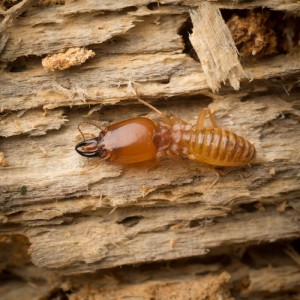
Among the myriad of insects and rodents that create a lot of inconvenience and harm to homeowners around the world, the most dangerous are termites. Commonly referred to as “white ants,” termites without outside help can ruin and destroy all load-bearing wooden structures of a house within a couple of years, so the owners of wooden houses of all countries are interested in answering the question of how to get rid of termites.
to contents ↑Fighting termites in a wooden house
Reliable protection of structures and structures requires expensive and time-consuming activities. A secretive lifestyle and a special manner of absorbing cellulose lead to the fact that termites can live in a house for a long time, remaining completely unnoticed. The first 5 years after the settlement of “white ants”, the consequences of their destructive “labors” may not even be seen, but then it will be simply too late.
Therefore, first of all, all possible steps must be taken to protect the house from herbivorous insects, and if they have already wound up, then get rid of termites as soon as possible.
To effectively deal with unsolicited “tenants”, you need to know their features, strengths and weaknesses, which means you need to know as much as possible about them.
to contents ↑Termites and their types
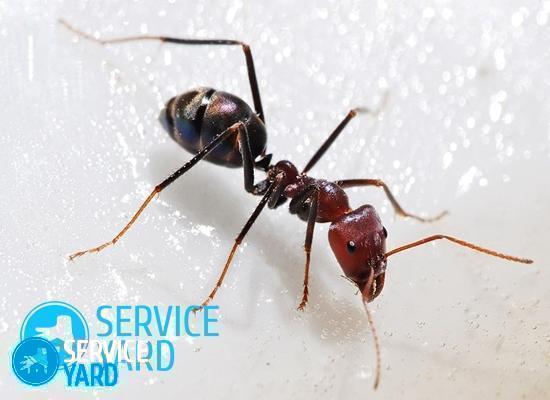 Termites belong to the category of primitive public herbivorous insects. They are relatives of cockroaches. White ants got their name because of the color of the working individuals, and these insects differ from real ants in the absence of a narrow constriction that separates the chest from the abdomen.
Termites belong to the category of primitive public herbivorous insects. They are relatives of cockroaches. White ants got their name because of the color of the working individuals, and these insects differ from real ants in the absence of a narrow constriction that separates the chest from the abdomen.
Regions of distribution
The largest termite colonies live in tropical and subtropical regions, fewer of them are found in warm regions of a temperate climate.
Important! According to various studies, termites cause economic damage of several billion dollars a year, and the consequences of the invasion of these insects are sometimes catastrophic. For example, in South America, because of the constant presence of “white ants,” a book older than 50 years is rarely found in cities.
Food
Before getting rid of termites, it will not be superfluous to know what serves them as food. The main food for termites is cellulose, which is found in wood, tree leaves and grass. Therefore, getting into the house, termites can cause significant economic damage, because they are not limited to wood, but eat everything, in which the proportion of cellulose is high.
In the natural environment, termites eat up dead branches, as well as rotting parts of tree trunks. A number of their species feed on cereals, collecting their dry shoots in the chambers of their underground nests (termite mounds). Some termites feed dead leaves and humus from tropical soils.
Types of Termites
Like all social insects living in colonies, termite individuals are divided into 3 main groups:
- Working individuals.
- The soldiers.
- Individuals capable of sexual reproduction.
Activities
Termite adult specimen develops from a larva without preliminary transformation into a pupa (incomplete metamorphosis). Only reproductive individuals have wings. At the base of the wing of such insects there is a seam along which the wings break off after resettlement for the purpose of reproduction.
Working individuals do not have genitals and it is working termites that are whitish and light in color, which gave the name insects “white ants”.
The main task of the soldiers is to protect the colony from ant predators. To do this, they have different weapons of defense:
- outgrowth with a poisonous secret;
- gnawing mandibles.
to contents ↑Important! Insect nests can be found in different places: tree trunks, stumps, logs, on the ground. Termites do not like light, so they spend almost their entire lives in the dark. Since these insects cannot eat only what is next to the colony, they need to build covered galleries, thanks to which they communicate with food objects: trees, buildings, etc.
How to detect termites?
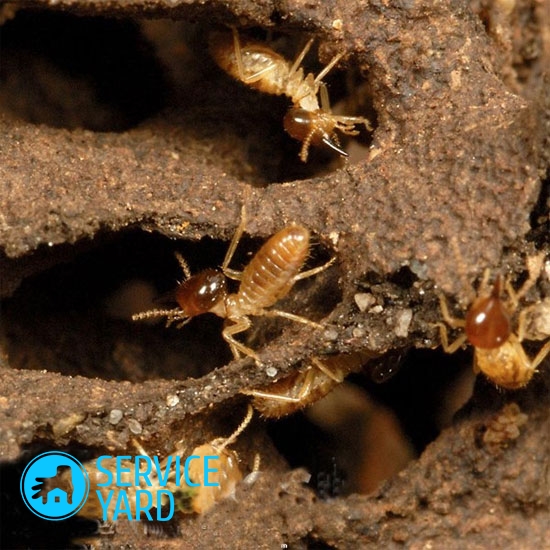 In order to deliberately get rid of termites, it is necessary to discover the places of their settlement. Insects eat not only wood, but also everything that is made of it: wooden tools, window sills, railings, ceilings, ornamental plants, books, etc.
In order to deliberately get rid of termites, it is necessary to discover the places of their settlement. Insects eat not only wood, but also everything that is made of it: wooden tools, window sills, railings, ceilings, ornamental plants, books, etc.
Important! If you have not seen direct evidence of an insect invasion, this does not mean that you need to remain indifferent to the problem, because sagging floors and small holes in the wooden elements of the house, as well as voids in the supporting structures, are already serious signs of termites.
Termites can be identified as follows:
- Browse the woodwork of your home: in some places you can see small, round holes.
- Explore the subfloor and foundation supports. Use a screwdriver to check for voids, and the whole tree for strength. If the tree easily lends itself and splits into parts, then the problem with the presence of uninvited “tenants” is present.
- Pay attention to the small heaps of frayed wood under wooden products.
- Check for tiny black, tan, or tan termite excrement. The presence of litter in weakened wooden elements indicates the invasion of termites.
- Examine the walls of the foundation from the inside and outside for the presence of dirt passages. Underground insects arrange a system of moves from the ground, and wood insects erect a termite inside wooden structures.
- Check if the wooden frame of the house is damaged at the height of the first floor, especially at the junction of the foundation and walls, as well as under the front door.
- Carefully inspect everything with a flashlight: if no damage is visible outside, tap the tree with the handle of a large screwdriver (large awl) for voids.
- Determine which termites you have wound up: underground or wood. The first - live in the ground and in the wooden structures of the house, and the second - settle only in wood. In addition to wooden structures, underground termites can live in woodpiles and dunks near the house. Underground termites cause much more significant harm than wood termites; therefore, different means may be needed to combat them.
to contents ↑Important! Termites do not like light, so look for them in all the darkened areas of the house where daylight does not fall.
How to get rid of termites at home?
If you find uninvited “guests” in your home, it is better to contact a special company that has experience in termite destruction. But if you are still confident in your abilities, then use the following methods to destroy termites.
Method # 1 - Cardboard Trap
- Moisten a couple of cardboard sheets with water.
- Fold sheets one on top of the other.
- Place them in the area of possible termite habitat. Since the food of insects is cellulose, then for them it will be an excellent bait.
- As soon as the termites fill the cardboard sheets, take them to a safe place and burn them.
- Repeat the procedure as many times as needed.
Important! The trap will not solve the problem as a whole, but it will help get rid of termites in the amount of hundreds or two individuals. And in order to cause serious damage, combine this method with other methods of struggle.
Method No. 2 - Nematodes Worms
Primary strip small worms are natural parasites of garden pests, including termites. Nematodes are introduced into the host organism for their own development, for example, in termite larvae, and kill them within 48 hours. Nematodes use the body of insects for breeding sites.
Important! If you decide to take such a step to get rid of termites, consider the following tips:
- You can buy worms at a local garden store or online. To date, there are 5 varieties of these worms.
- If you use nematodes in soil with a temperature above 15 ° C, then do it immediately after purchase.
- If you do not use the worms immediately, then store them in the refrigerator, and place them in the ground in the early morning or after sunset, since ultraviolet is very harmful to these worms.
Method No. 3 - Sunlight
If termites were wound up not in the construction of the house itself, but in some furniture or interior item, then take the product to sunlight that will kill insects. Take the furniture out into the open in sunny weather for 2-3 days.
Important! This method works best when combined with a cardboard trap to lure and then kill insects.
Method number 4 - cold
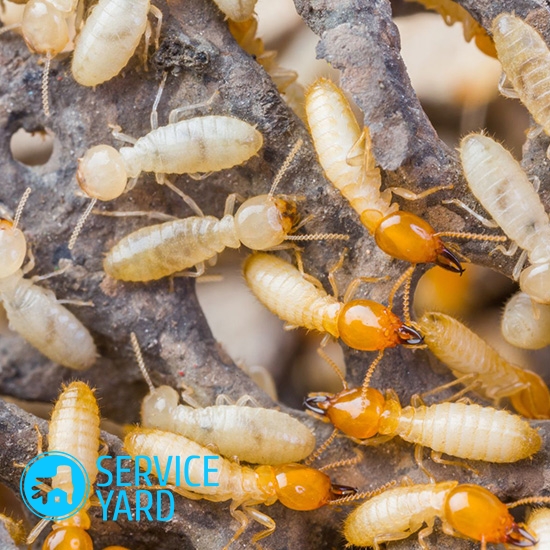 If you live in a rainy region and the sun rarely appears, then use an alternative option - freezing furniture. If possible, disassemble the interior and place in a large freezer for 2-3 days.
If you live in a rainy region and the sun rarely appears, then use an alternative option - freezing furniture. If possible, disassemble the interior and place in a large freezer for 2-3 days.
Important! Although this method is quite difficult to apply, in relation to large elements of furniture, however, it guarantees the death of termites.
Method No. 5 - insecticides
You can spray and treat the places where termites are found with poisons: Imidacloprid, Chlorfenapyr, Chlorpyrifos, Fipronil, etc.
Important! Insecticides are not toxic to humans, however, they are carcinogens, and can cause serious health problems in other animals at their places of use.
The most commonly used and effective method of controlling termites in a wooden house at home is the use of boric acid, which kills the nervous system of insects by dehydrating it. Boric acid can be used in the following way:
- As a bait. Apply boric acid (or its solution) to wood or other cellulose-containing material.
- Ready-made baits can also be placed directly in the nest of termites.
Important! Check the bait regularly and replenish it with boric acid.
Method # 6 - Lubricating Termite Locations
Locations of dangerous insects can be greased with the following means:
- A mixture of boron powder with honey and sugar. Add a drop of water to the mixture to make a paste. Termites will contact the mixture and transfer it to the den, infecting the entire colony.
- A mixture of turpentine and kerosene in a ratio of 1: 3.
- A saturated solution of naphthalene in gasoline.
- 200 parts turpentine + 100 parts tar + 15 parts creosote + 30 parts naphthalene.
- 100 parts of alcohol + 3 parts of mercuric chloride.
- Resin water mixed with boric acid and borax (2-4 percent).
- 100 parts of kerosene + 100 parts of drying oil + 25 parts of naphthalisol + 15 parts of naphthalene.
- 100 parts of turpentine + 10 parts of naphthalene + 5 parts of phenol + 3 parts of lysol + 10 parts of wood tar.
Important! In addition to the above formulations, you can find many other coatings that need to be processed localization of insects. Many of them really help to quickly get rid of termites, but it all depends on how large the population is.
Method number 7 - aeration
To deal with termites and other woodworms, a method of aeration of wooden elements has been known for a long time:
- Carbon disulphide.
- Hydrocyanic (cyanide) acid.
- Chloropicrin.
If you decide to use this method to get rid of termites, consider the following requirements:
- The rules for carbonation, as well as building codes recommend flameless smoke bombs that are made of HCCH (hexachlorocyclohexane) or DDT (dichlorodiphenyltrichloroethane) with a combustible filler.
- Before the aeration process, all rooms should be freed from people, animals, food, and all cracks are covered with alabaster mortar and waxed paper.
- All openings, ventilation ducts, blowers of furnaces, hearths and the like tightly close, and the room is sealed.
- The duration of aeration is 3-5 days.
- After processing, the rooms are thoroughly ventilated, and the holes on the surface of wooden structures are covered.
Important! In residential buildings, gasification has not received practical distribution due to a number of shortcomings: some chemicals are the strongest poisons and affect human health. In addition, gas penetration into the thickness of wooden structures, into wooden beams walled up in stone walls is limited, which means that the fighter effect is greatly reduced.
Method number 8 - the help of professionals
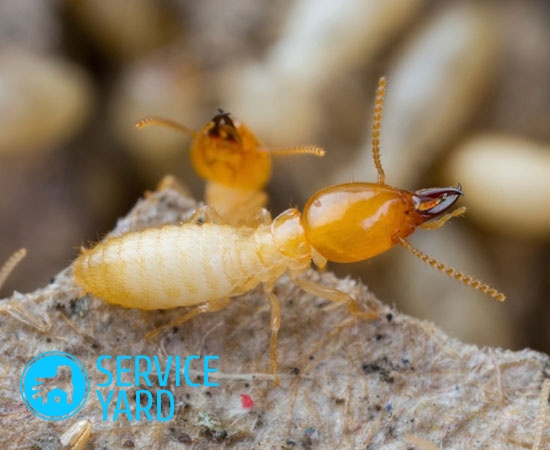 If the invasion of termites is too large, and your home is too important for you to give insects a second chance, we recommend contacting the companies that are engaged in pest control. In this case, the experts professionally and efficiently, and most importantly - with a guarantee, will process the premises infected with insects.
If the invasion of termites is too large, and your home is too important for you to give insects a second chance, we recommend contacting the companies that are engaged in pest control. In this case, the experts professionally and efficiently, and most importantly - with a guarantee, will process the premises infected with insects.
Some companies give a power of attorney, according to which the customer has the right to free regular inspections of the already processed premises. The duration of such an agreement may last from 1 to 2 years. Before contacting a company, you should:
- Read reviews about the company.
- Get at least three offers from competing firms.
- Ask about the methods and means of processing the premises.
- Ensure the safety of the funds used.
- Ask about a written guarantee for the absence of termites in the house for 2 years after the disinsection.
Helpful hints:
- Most professional insect repellents are commercially available, so for a small amount you can carry out pest control yourself without spending money on professional services.
- Destruction of woodworkers who have already developed in the wood structure, it is necessary to carry out comprehensively, using structural and chemical measures. It is necessary to carry out the treatment before the beetles leave the wooden structures, and their larvae approach the outer layers of wood. This usually happens in spring.
- Simultaneously with the fight against termites, it is necessary to carry out antiseptic repair of buildings and all structures.
to contents ↑Important! You can not be limited to the extermination of insects in a particular building, they should be destroyed in the nests. For example, in Central Asia, termite mounds have been poured with oil or oil for a long time, and K. Escherich proposes to pump the termite with a mixture of sulfur and arsenic vapor.
Termite Prophylaxis
In order not to search for termite remedies, it is better to take preventive measures:
- When building a house, the following nuances must be taken into account:
- Housing should be on a high foundation. All wooden structures should be located above ground level and not in contact with it.
- Around the house, it is necessary to equip a good drain so that the earth around the house is not too wet, because termites are attracted by a damp and humid environment, and their survival requires water.
- Be sure to check with the builders what kind of wood does not like termites. It can be cedar or mahogany.
- During construction, use special films that are laid on brick and other walls. They serve as a barrier to termites and other unsolicited insects.
- If the house has already been built, then to reduce the humidity and for a reliable barrier to prevent insects from entering the house, dig a trench along the entire perimeter of the house with a depth and width of at least 1 m.Fill it with sand (termites move on the ground and will not dig a path through the sand). For greater reliability and effectiveness, treat the sand with some insecticides or other improvised anti-wood insects.
- Make sure that all pipes and sewers in and around your house do not leak. As you accumulate, remove all unwanted moisture.
- Clean your gutters regularly, as this is an ideal haven for termites.
- In the room, provide reliable ventilation so that excessive humidity is not kept in the house.
- Reinstall the wooden fence around the house on a hill of cement so that the tree does not come into contact with the ground.
- Treat all the places of contact of the tree with the external environment, especially the bottom of the wooden walls of the house, the wooden thresholds at the entrance to the house and the joints of the corners of the wooden walls with plaster, the recipes of which were described above.
- Seal all cracks and crevices in the walls of the house with sealant to prevent termites from entering the room.
- In the paint or varnish during the construction or painting of the house, add 0.1% permethrin (1 tbsp. Per 10 liters of water). This will discourage the termites from any desire to approach the dwelling.
Important! Add permethrin to the cement when leveling the floor, or to glue if you are laying a wooden floor. The tool is absolutely safe for humans..
- Do not keep stocks of firewood and other wooden materials in the immediate vicinity of housing, because such a warehouse actually invites termites to the house. If you need firewood at the house or bath, then cover them completely. This will ensure their complete drying out and make them less attractive to insects. Firewood can also be treated with permethrin.
- Mosquito nets on doors, balconies and windows will also not be superfluous.
- If possible, shrubs growing near the house are best transplanted away so that the moisture in their roots does not attract termites to the house. If there is no possibility to transplant plants, then try not to wet the walls of the house when watering.
to contents ↑Important! You can get rid of termites in the bath in the same ways and means as in the house, but remember that removing them from the site, and even more so from the wood, is quite difficult. Therefore, do not ignore preventive measures, treat all wood with antiseptics, which will scare off not only termites, but also wood-cutting beetles and fungi.
Stock footage
Bringing termites, unlike other insects, is very difficult on its own. Therefore, if a problem arises, still use the services of professionals who have experience, effective tools, equipment, and a proven methodology.
- How to choose a vacuum cleaner taking into account the characteristics of the house and coatings?
- What to look for when choosing a water delivery
- How to quickly create comfort at home - tips for housewives
- How to choose the perfect TV - useful tips
- What to look for when choosing blinds
- What should be running shoes?
- What useful things can you buy in a hardware store
- Iphone 11 pro max review
- Than iPhone is better than Android smartphones



